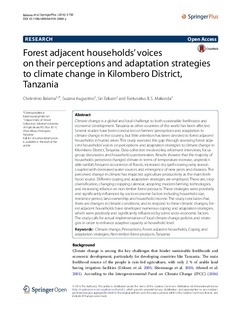| dc.description.abstract | Climate change is a global and local challenge to both sustainable livelihoods and economic development. Tanzania as other countries of the world has been affected. Several studies have been conducted on farmers’ perceptions and adaptation to climate change in the country, but little attention has been devoted to forest adjacent households in humid areas. This study assessed this gap through assessing forest adjacent households’ voices on perceptions and adaptation strategies to climate change in Kilombero District, Tanzania. Data collection involved key informant interviews, focus group discussions and household questionnaires. Results showed that the majority of households perceived changed climate in terms of temperature increase, unpredictable rainfall, frequent occurrence of floods, increased dry spells during rainy season coupled with decreased water sources and emergence of new pests and diseases. The perceived change in climate has impacted agriculture productivity as the main livelihood source. Different coping and adaptation strategies are employed. These are; crop diversification, changing cropping calendar, adopting modern farming technologies, and increasing reliance on non-timber forest products. These strategies were positively and significantly influenced by socio-economic factors including household size, residence period, land ownership and household income. The study concludes that, there are changes in climatic conditions; and to respond to these climatic changes, forest adjacent households have developed numerous coping and adaptation strategies, which were positively and significantly influenced by some socio-economic factors. The study calls for actual implementation of local climate change policies and strategies in order to enhance adaptive capacity at household level. | nb_NO |

